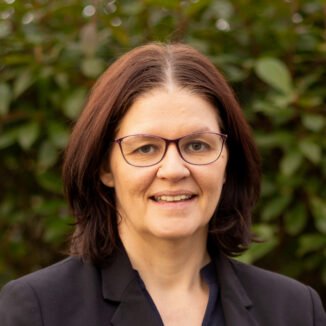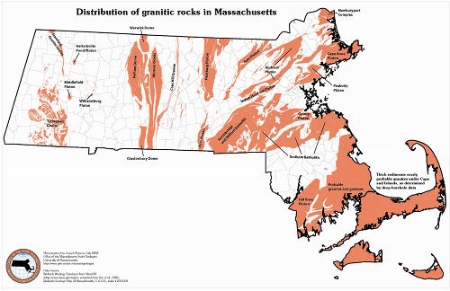Now, DOE is investing in practical new geothermal research through a grant via the American Association of State Geologists.
AMHERST, Mass. – University of Massachusetts Amherst geologists say that hot rocks beneath granite-rich New England–way down, 2.5 to 4 miles deep–could represent the next great clean energy source, with a potential to generate enough local electricity and direct heat to serve small towns, schools and hospitals.
Harnessing local geothermal energy for such systems–not from volcanoes or geysers but from garden-variety rocks found in certain special granites–has the potential to cut electricity costs by 25 percent to 50 percent, according to the National Renewable Energy Laboratory at the Department of Energy (DOE). Many businesses are waiting with new technologies designed to take advantage of this potential new source.
Now, DOE is investing in practical new geothermal research through a grant via the American Association of State Geologists. Steve Mabee, the Massachusetts state geologist, and Mike Rhodes, professor of volcanology at UMass Amherst, with Margaret Thomas, the Connecticut state geologist, recently received a three-year, $441,062 grant to conduct the first comprehensive survey of geothermal energy potential of the rocks in the Northeast. Their work will also be used to create a national geothermal database for the entire country.
“I think of geothermal power as the Cinderella of alternative energy,” says Rhodes. “Most people don’t pay it any attention. It’s really an attractive alternative. Unlike wind and solar energy, it works 24 hours a day, seven days a week, is unobtrusive and environmentally friendly. You don’t need volcanoes or geysers to have an opportunity to tap geothermal energy. Most of the Earth below our feet is very hot. It’s just a matter of knowing where to tap it.”
New England is endowed with abundant granites and gneisses that generate heat deep within the earth and are a potential source of local energy, say Mabee and Rhodes. Some developed countries, notably Switzerland, France, Australia and the U.K., are ahead of the United States in developing this type of geothermal resource, “but that’s going to change,” predicts Rhodes. “Many write off New England’s potential, but we certainly do not agree. After all, 33 percent of the state is underlain with granitic rocks.”
Mabee adds, “What we propose is to see how hot our rocks are and where they are located. Drilling methods are improving, the technology for transferring energy from deep underground is advancing and economic conditions may soon make it more cost-competitive. So when towns and businesses start asking where to drill to tap that heat source, we’ll be ready. That’s the position we want Massachusetts to be in.”
A post-doctoral researcher and several undergraduates supervised by Mabee and Rhodes will be collecting about 450 samples across the two states as part of the survey. They’ll bring rocks back to Rhodes’s UMass Amherst laboratory, where crushed and powdered samples will be analyzed by X-ray spectrography.
A hot granite is one that contains enough radioactive thorium, uranium and potassium to heat water to 300 to 400 degrees Fahrenheit (150 to 250 degrees Celsius). But as energy transfer technologies improve, the temperature at which it’s profitable to use geothermal energy in building projects should get lower, which means boreholes won’t need to be as deep, so costs are lower.
The economics of geothermal look great and keep getting better, Rhodes notes. One technology calls for geothermal power stations to pump cold water deep into fractured hot granites through one hole and recover hot water and steam from others. The spent underground water, now cooled, is recycled back down the original hole. Another, newer method being developed uses solid state energy transfer technology which does not pump water into the ground or rely on fracturing to enhance the rock’s permeability.
In the final study year, Mabee and Rhodes will conduct geophysical and gravimetric analyses to more precisely describe and map the most promising hot granites in Massachusetts and Connecticut.
Basic requirements for a promising geothermal zone not only include the presence of the radioactive elements in granite bodies at least three miles thick, but “it’s best if the granite is also insulated by a sediment layer that acts like a blanket on top,” Rhodes adds. In Massachusetts and Connecticut, the Connecticut River Valley is one such promising region and another is in southeast Massachusetts, the Narragansett Basin. Both are near many towns and colleges that might one day be able to generate clean, green electric power as well as direct heat for buildings from these local energy sources.
Internationally, there is already a working pilot project poised to begin producing power near Innamincka, Australia. Its power station pumps cold water 2.5 miles (4 kilometers) down, which returns as steam at 482 degrees Fahrenheit (250 degrees Centigrade), hot enough to power a turbine. With a recent $90 million infusion from the Australian government, the plant is expected to soon begin producing about 50 megawatts of electric power, enough to serve about 50,000 homes, Rhodes reports.
He summarizes, “We’re blessed with a lot of granites in Massachusetts and Connecticut. With high population density, this region has high energy demand so the economics could make sense. We believe it is critically important to carefully evaluate the potential of this clean, renewable and local energy source. Geothermal energy power might very well make a locally significant contribution to our future energy needs.”
More Information
| Contact: | Janet Lathrop 413/545-0444 |
Share your industry press now!
Are you a PR agency or sustainability-focused organization? Join the World of Renewables network FREE today and gain exclusive access to our platform to promote your business, share the latest industry news, and connect with a global audience of 700,000+ renewable energy professionals.
Register Now to start posting your updates and showcase your expertise to a highly engaged, environmentally-conscious community.
Find out more about our Content Partnership Programs.*2024 AWARD WINNER* Websites & Mobile Sites, Webby Winner, Peoples Voice 2024






















